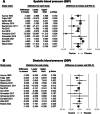Insights into the cardiovascular benefits of taurine: a systematic review and meta-analysis
- PMID: 39148075
- PMCID: PMC11325608
- DOI: 10.1186/s12937-024-00995-5
Insights into the cardiovascular benefits of taurine: a systematic review and meta-analysis
Abstract
Background: Cardiovascular disease (CVD) remains the foremost cause of mortality globally. Taurine, an amino acid, holds promise for cardiovascular health through mechanisms such as calcium regulation, blood pressure reduction, and antioxidant and anti-inflammatory effects. Despite these potential benefits, previous studies have yielded inconsistent results. This meta-analysis of randomized controlled trials (RCTs) aims to evaluate the existing evidence on the quantitative effects of taurine on hemodynamic parameters and cardiac function grading, which are indicative of overall cardiovascular health and performance.
Methods: We conducted an electronic search across multiple databases, including Embase, PubMed, Web of Science, Cochrane CENTRAL, and ClinicalTrials.gov, from their inception to January 2, 2024. Our analysis focused on key cardiovascular outcomes, such as heart rate (HR), systolic blood pressure (SBP), diastolic blood pressure (DBP), left ventricular ejection fraction (LVEF), and New York Heart Association (NYHA) Functional Classification. Meta-regression was applied to explore dose-dependent relationships based on the total taurine dose administered during the treatment period. A subgroup analysis, stratified according to the baseline disease status of patients, was also conducted.
Results: The analysis included a pooled sample of 808 participants from 20 randomized controlled trials. Taurine demonstrated a significant reduction in HR (weighted mean difference [WMD] = -3.579 bpm, 95% confidence interval [CI] = -6.044 to -1.114, p = 0.004), SBP (WMD = -3.999 mm Hg, 95% CI = -7.293 to -0.706, p = 0.017), DBP (WMD: -1.435 mm Hg, 95% CI: -2.484 to -0.386, p = 0.007), NYHA (WMD: -0.403, 95% CI: -0.522 to -0.283, p < 0.001), and a significant increase in LVEF (WMD: 4.981%, 95% CI: 1.556 to 8.407, p = 0.004). Meta-regression indicated a dose-dependent reduction in HR (coefficient = -0.0150 per g, p = 0.333), SBP (coefficient = -0.0239 per g, p = 0.113), DBP (coefficient = -0.0089 per g, p = 0.110), and NYHA (coefficient = -0.0016 per g, p = 0.111), and a positive correlation with LVEF (coefficient = 0.0285 per g, p = 0.308). No significant adverse effects were observed compared to controls. In subgroup analysis, taurine significantly improved HR in heart failure patients and healthy individuals. Taurine significantly reduced SBP in healthy individuals, heart failure patients, and those with other diseases, while significantly lowered DBP in hypertensive patients It notably increased LVEF in heart failure patients and improved NYHA functional class in both heart failure patients and those with other diseases.
Conclusions: Taurine showed noteworthy effects in preventing hypertension and enhancing cardiac function. Individuals prone to CVDs may find it advantageous to include taurine in their daily regimen.
Keywords: Cardiac function; Heart failure; Hypertension; Nutrition; Taurine.
© 2024. The Author(s).
Conflict of interest statement
The authors declare no competing interests.
Figures





References
-
- Cardiovascular diseases (CVDs) https://www.who.int/news-room/fact-sheets/detail/cardiovascular-diseases...
-
- Piepoli MF, Hoes AW, Agewall S, Albus C, Brotons C, Catapano AL, Cooney M-T, Corrà U, Cosyns B, Deaton C, et al. 2016 European Guidelines on cardiovascular disease prevention in clinical practice: The Sixth Joint Task Force of the European Society of Cardiology and Other Societies on Cardiovascular Disease Prevention in Clinical Practice (constituted by representatives of 10 societies and by invited experts)Developed with the special contribution of the European Association for Cardiovascular Prevention & Rehabilitation (EACPR). Eur Heart J. 2016;37:2315–81. 10.1093/eurheartj/ehw106 - DOI - PMC - PubMed
Publication types
MeSH terms
Substances
Grants and funding
LinkOut - more resources
Full Text Sources

